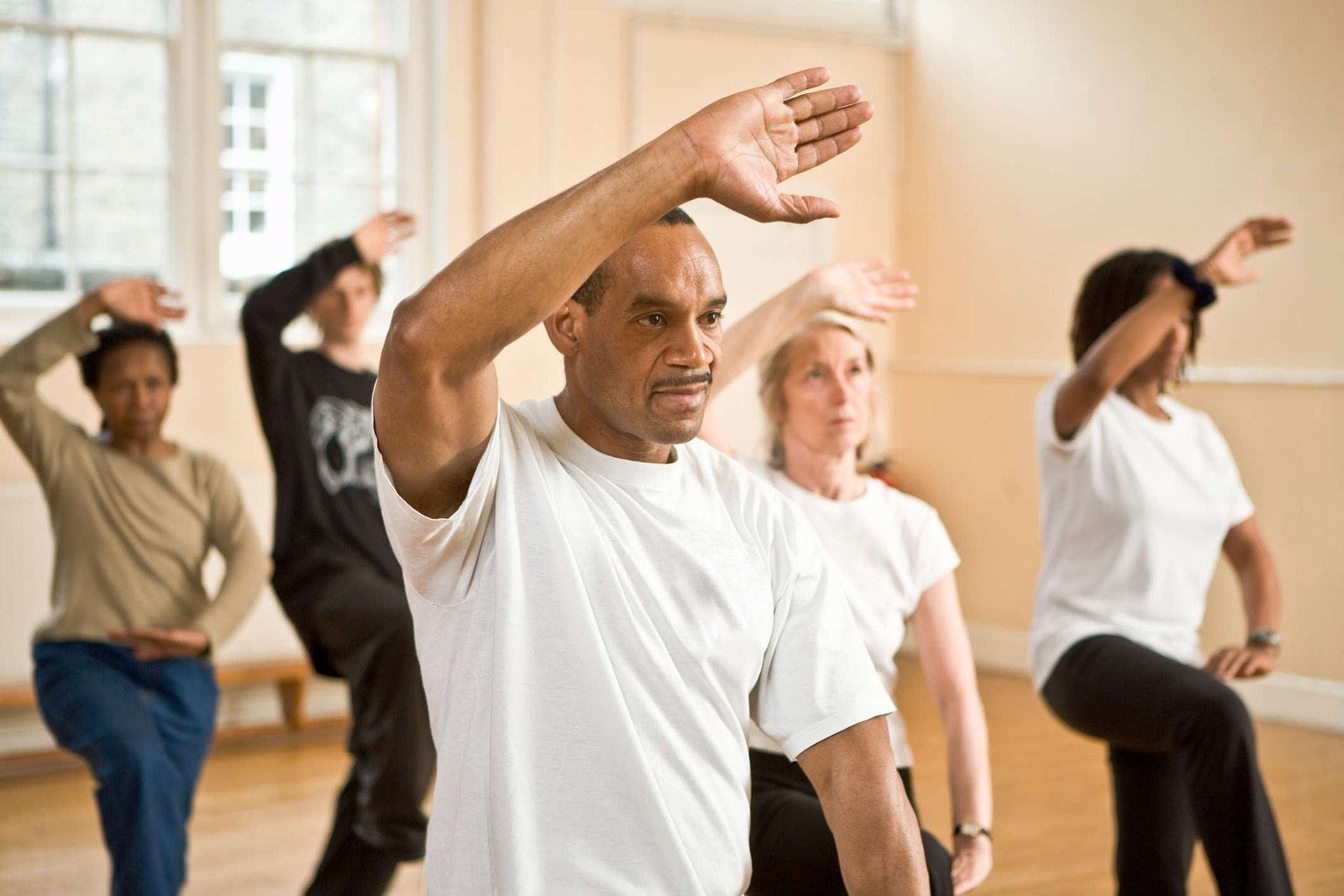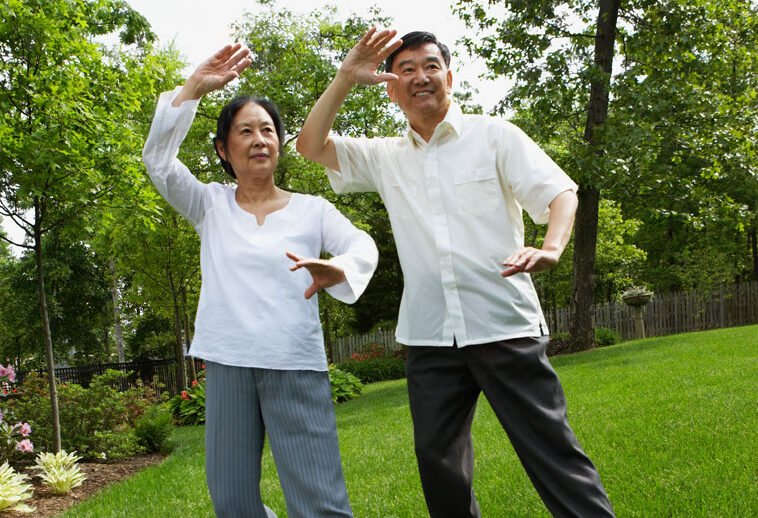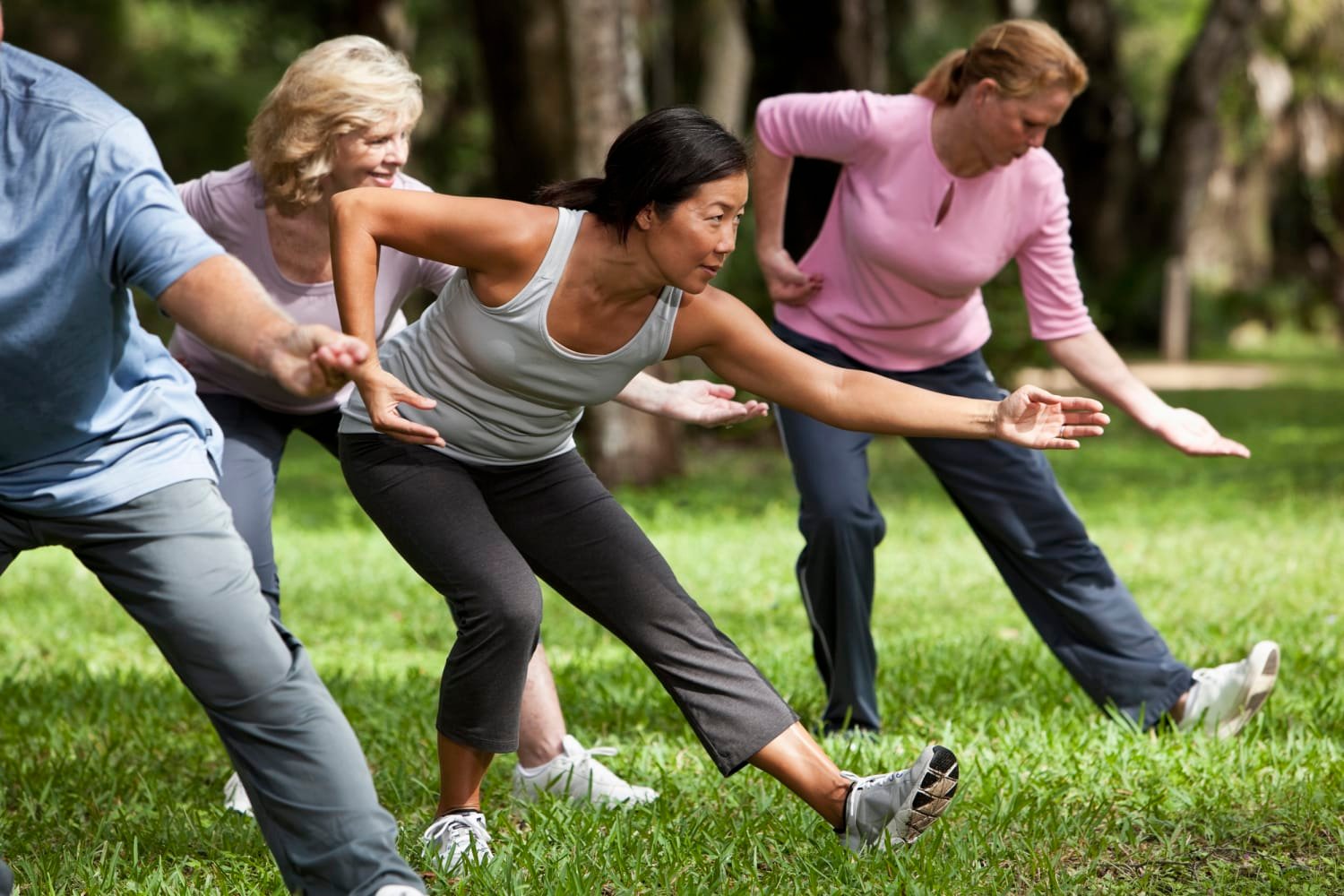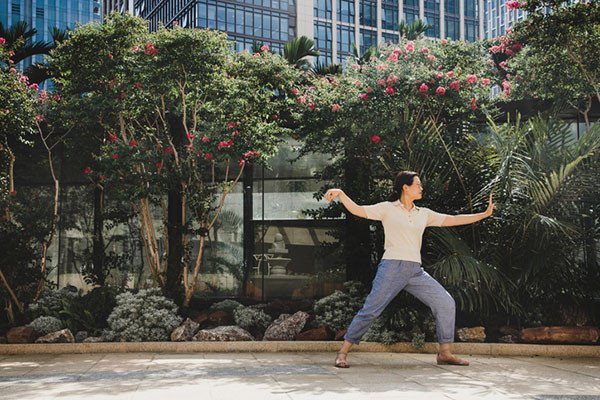Whether you’re searching for a way to unwind after a long day or seeking a new exercise routine that doesn’t leave you feeling depleted, look no further than Tai Chi. This ancient Chinese practice offers a unique blend of gentle movements and stress-relieving benefits that can leave you feeling rejuvenated and calm. With its slow and deliberate motions, Tai Chi has been shown to improve balance, increase flexibility, and promote a sense of overall wellbeing. So why not give it a try? Step into the world of Tai Chi and discover the relaxing benefits that await you.

This image is property of aarp-content.brightspotcdn.com.
What is Tai Chi?
Tai Chi is an ancient Chinese martial art that has gained popularity worldwide for its numerous physical and mental health benefits. Often referred to as “moving meditation,” Tai Chi involves a series of slow, flowing movements combined with deep breathing and mental focus. It is a holistic practice that balances the body, mind, and spirit, promoting overall well-being.
Origin and History of Tai Chi
Tai Chi originated in China during the 17th century and was developed by a martial artist named Zhang Sanfeng. Legend has it that Zhang, inspired by observing a snake and a crane in combat, created a set of movements that incorporated the principles of energy flow and harmony. Over time, Tai Chi evolved into different styles, each emphasizing various aspects of the practice.
Philosophy behind Tai Chi
At the heart of Tai Chi is the philosophy of Yin and Yang, which represents the balance and interconnection of opposing forces within the universe. The practice reflects this philosophy through its slow and continuous movements, allowing practitioners to cultivate a sense of inner peace and harmony. Tai Chi also embraces the principles of Taoism, emphasizing the importance of mindfulness, balance, and the cultivation of one’s life force or “Qi.”
Key Principles of Tai Chi
Tai Chi is guided by several key principles that shape the practice and its benefits. These principles include relaxation, alignment, and coordination of the body, as well as the cultivation of internal energy and mindfulness. By applying these principles, practitioners can experience improved physical and mental well-being.
Physical Benefits of Tai Chi
Tai Chi offers a wide range of physical benefits that contribute to overall health and vitality.
Enhanced Balance and Stability
Through its focus on postural alignment and weight shifting, Tai Chi helps improve balance and stability. The slow and controlled movements challenge the body’s ability to maintain equilibrium, making it an excellent practice for individuals of all ages, particularly older adults who are at a higher risk of falls.
Improved Flexibility and Joint Health
The gentle and fluid movements in Tai Chi promote flexibility and joint mobility. Regular practice can help increase range of motion, loosen tight muscles and joints, and alleviate stiffness and discomfort.
Increased Strength and Endurance
While Tai Chi may appear gentle, the slow and controlled movements engage various muscle groups, leading to enhanced strength and endurance. It helps develop core stability, leg strength, and overall muscle tone, providing a low-impact yet effective form of exercise.
Reduced Risk of Falls and Injuries
By improving balance, coordination, and strength, Tai Chi can significantly reduce the risk of falls and injuries, particularly in older adults. The practice enhances proprioception, the body’s awareness of its position in space, reducing the likelihood of accidents.
Enhanced Respiratory Function
The deep breathing and focus on relaxation in Tai Chi can improve respiratory function. The slow and controlled breathing helps strengthen the diaphragm and lungs, promoting efficient oxygenation of the body and increasing lung capacity.

This image is property of www.health.com.
Mental and Emotional Benefits of Tai Chi
In addition to its physical benefits, Tai Chi also offers a range of mental and emotional advantages, promoting overall well-being and mental clarity.
Stress Reduction and Relaxation
One of the primary benefits of Tai Chi is its ability to reduce stress and induce a state of relaxation. The combination of slow, flowing movements and focused breathing helps calm the mind, release tension, and promote a sense of calm and tranquility.
Improved Mental Clarity and Focus
Tai Chi requires focused attention and concentration, which can improve mental clarity and enhance cognitive function. Regular practice has been shown to improve memory, attention span, and problem-solving abilities.
Enhanced Mood and Emotional Well-being
Regular practice of Tai Chi has been associated with improved mood and emotional well-being. The combination of gentle movements, deep breathing, and mindfulness can help reduce symptoms of anxiety and depression, promoting a positive outlook on life.
Boosted Cognitive Function
Research suggests that Tai Chi may have positive effects on cognitive function, particularly in older adults. The combination of physical exercise, mental focus, and relaxation can contribute to improved cognitive abilities, including memory, attention, and overall brain health.
Tai Chi for Stress Relief
Tai Chi is often recommended for stress relief due to its unique mind-body approach and its ability to promote relaxation and inner calm.
Mind-Body Connection in Tai Chi
Tai Chi emphasizes the mind-body connection, promoting the integration of physical movements, deep breathing, and mental focus. By bringing attention to the present moment and synchronizing breath with movement, practitioners can release stress and improve overall well-being.
Breathing Techniques and Meditation
Deep and mindful breathing is an essential component of Tai Chi. Practitioners are encouraged to breathe deeply into the lower abdomen, allowing the breath to flow naturally and smoothly. This focus on breathing is akin to meditation, helping to calm the mind and alleviate stress.
Promotion of Relaxation Response
Tai Chi activates the body’s relaxation response, which is the opposite of the stress response. Through slow and controlled movements, deep breathing, and mindfulness, the practice helps reduce the production of stress hormones, lowers blood pressure, and promotes a sense of calm and relaxation.
Reduction of Anxiety and Depression Symptoms
Studies have shown that regular practice of Tai Chi can significantly reduce symptoms of anxiety and depression. The combination of physical exercise, relaxation techniques, and the meditative aspects of the practice help alleviate stress, improve mood, and enhance overall mental well-being.

This image is property of health.wordpress.clevelandclinic.org.
How to Get Started with Tai Chi
To start your Tai Chi journey, it is essential to find a qualified instructor, choose the right style of Tai Chi, and familiarize yourself with the basic movements and warm-up exercises.
Finding a Qualified Instructor
Finding a qualified Tai Chi instructor is crucial to ensure proper instruction and guidance. Look for instructors who have undergone extensive training and possess certifications from reputable Tai Chi organizations. Personal recommendations, online directories, and community centers are excellent sources for finding qualified instructors.
Choosing the Right Style of Tai Chi
There are different styles of Tai Chi, each with its own characteristics and emphasis. Some of the most popular styles include Chen, Yang, Wu, and Sun. It is essential to research and understand the differences between the styles to choose one that resonates with your goals and preferences.
Equipment and Attire for Tai Chi
Tai Chi can be practiced with minimal equipment and attire. Loose-fitting clothing that allows for unrestricted movement is recommended, along with flat-soled shoes or bare feet. Some individuals prefer to use Tai Chi swords or fans for specific styles, but they are not necessary for beginners.
Basic Tai Chi Movements and Warm-up Exercises
Tai Chi movements are typically gentle, flowing, and based on a series of postures and transitions. Beginners can start with simple warm-up exercises, which include gentle stretching, joint rotations, and coordination exercises. These warm-up exercises prepare the body for the Tai Chi movements and help prevent injuries.
Different Styles of Tai Chi
Tai Chi encompasses various styles, each with its unique characteristics, movements, and principles. Some of the most popular styles include Chen, Yang, Wu, Sun, and several others.
Chen Style Tai Chi
Chen Style Tai Chi is considered the oldest and most traditional style. It incorporates both explosive power and slow, flowing movements, making it suitable for practitioners of different fitness levels. Chen Style Tai Chi involves intricate and challenging movements, including silk reeling, spiraling energy, and explosive power releases.
Yang Style Tai Chi
Yang Style Tai Chi is the most widely practiced style, known for its slow, graceful movements and emphasis on health benefits. It is characterized by broad and open postures, relaxed and smooth transitions, and an overall focus on balance and stability. Yang Style Tai Chi is suitable for individuals of all ages and fitness levels.
Wu Style Tai Chi
Wu Style Tai Chi is known for its compact and controlled movements. It emphasizes small and refined postures, making it well-suited for individuals with limited space and mobility. Wu Style Tai Chi places importance on balance, alignment, and internal energy cultivation.
Sun Style Tai Chi
Sun Style Tai Chi combines elements of both traditional Tai Chi and other internal martial arts. It incorporates unique stepping patterns, agile footwork, and relaxed but powerful movements. Sun Style Tai Chi is characterized by its fluidity, gentle transitions, and an overall focus on health and well-being.
Other Variations
In addition to the popular styles mentioned above, there are other variations of Tai Chi, each with its specific characteristics and lineage. Some of these include Hao Style Tai Chi, Li Style Tai Chi, and Fu Style Tai Chi. Each variation has its own unique movements, principles, and teaching methods.

This image is property of media-cldnry.s-nbcnews.com.
Tai Chi for Specific Populations
Tai Chi is a versatile practice that can be adapted to suit the needs of different populations, including seniors, individuals with chronic conditions, individuals seeking mental health benefits, and those in rehabilitation and recovery.
Tai Chi for Seniors
Tai Chi is particularly beneficial for older adults due to its low-impact nature, focus on balance, and promotion of overall well-being. It helps improve strength, flexibility, and cognitive function and reduces the risk of falls. Tai Chi for seniors is often modified to accommodate physical limitations and can be practiced while seated or using a chair for support if needed.
Tai Chi for Individuals with Chronic Conditions
Tai Chi has shown promising results in managing various chronic conditions such as arthritis, hypertension, diabetes, and fibromyalgia. The gentle movements, deep breathing, and relaxation techniques can help alleviate pain, improve joint mobility, lower blood pressure, and enhance overall quality of life.
Tai Chi for Mental Health
Tai Chi is increasingly recognized for its mental health benefits. It can be a valuable tool for managing stress, anxiety, and depression. The meditative aspects of the practice, combined with the physical exercise and relaxation techniques, contribute to improved mood, reduced symptoms of mental disorders, and a greater sense of emotional well-being.
Tai Chi for Rehabilitation and Recovery
Tai Chi is employed in various rehabilitation settings to aid in recovery from injuries or surgeries. Its gentle, controlled movements promote muscle strength, flexibility, and mobility, aiding in the restoration of functional abilities. Tai Chi also provides a supportive and calming environment that can help individuals cope with the challenges of recovery and regain their confidence.
Safety Considerations for Tai Chi
While Tai Chi is generally safe and suitable for individuals of all fitness levels, it is important to take certain precautions to ensure a safe and enjoyable practice.
Consulting with a Healthcare Professional
Before starting Tai Chi, it is advisable to consult with a healthcare professional, especially if you have any underlying health conditions or concerns. They can provide personalized recommendations and ensure that Tai Chi is appropriate for your specific needs.
Warm-up and Cool-down Exercises
Like any physical activity, warming up before starting Tai Chi and cooling down afterward is essential. Perform gentle stretches and range-of-motion exercises to prepare the body for the practice and prevent muscle strain or injury.
Awareness of Personal Limits and Modifications
Listen to your body and respect your personal limits during Tai Chi practice. It is important to avoid overexertion and modify movements as needed. Each individual’s physical condition and abilities will vary, so it is crucial to practice within your comfort zone.
Avoiding Overexertion and Injury
Tai Chi is a low-impact exercise, but it is still important to avoid pushing yourself too hard, especially if you are new to the practice. Gradually increase the intensity and duration of your practice over time to avoid overexertion and minimize the risk of injury.

This image is property of domf5oio6qrcr.cloudfront.net.
Tai Chi and the Mindfulness Movement
Tai Chi and mindfulness share common principles and practices, making them highly compatible and complementary.
Similarities between Tai Chi and Mindfulness
Both Tai Chi and mindfulness involve cultivating awareness of the present moment, promoting a state of non-judgmental observation and acceptance. Both practices emphasize the mind-body connection, harnessing the power of focused attention and deep breathing to calm the mind and reduce stress.
Integration of Tai Chi with Mindfulness Practices
Tai Chi can be seamlessly integrated with mindfulness practices to enhance the benefits of both. By combining the slow and flowing movements of Tai Chi with mindfulness techniques such as body scanning, breath awareness, and loving-kindness meditation, practitioners can experience a deeper sense of relaxation and well-being.
Benefits of Combining Tai Chi and Mindfulness
The combination of Tai Chi and mindfulness amplifies the benefits of both practices. Practicing Tai Chi with a mindful mindset enhances body awareness, deepens relaxation, and promotes a greater sense of inner peace. Similarly, integrating mindfulness into Tai Chi enhances the mental clarity, focus, and stress reduction benefits of the practice.
Incorporating Tai Chi into Daily Life
Tai Chi can be integrated into various aspects of daily life to sustain the benefits of the practice beyond formal training sessions.
Practicing Tai Chi at Home
To establish a regular Tai Chi practice, consider setting aside dedicated time at home. Create a calm and comfortable space where you can practice the movements and engage in deep breathing and relaxation. Consistency is key, so aim to practice Tai Chi at the same time each day to establish a routine.
Tai Chi in the Workplace or Office
Tai Chi can be practiced in the workplace or office, even in limited spaces. Incorporate short breaks throughout the day to stretch, practice mindful breathing, and engage in a few Tai Chi movements. These mini-practice sessions can help reduce stress, improve focus, and enhance productivity.
Joining Community Tai Chi Classes
Joining community Tai Chi classes can provide social support and a sense of community. Interacting with fellow practitioners can enhance motivation, facilitate learning, and create a supportive and enjoyable practice environment. Look for local community centers, fitness facilities, or Tai Chi organizations that offer classes in your area.
In conclusion, Tai Chi is a holistic practice that offers numerous physical, mental, and emotional benefits. Through its gentle movements, deep breathing, and mindful focus, Tai Chi promotes relaxation, reduces stress, improves balance, flexibility, and strength, and cultivates overall well-being. Whether you are looking to enhance your physical fitness, manage stress, or simply find a practice that promotes a healthy mind-body connection, Tai Chi is a versatile and accessible option. Start your Tai Chi journey today and discover the transformative power of this ancient practice.